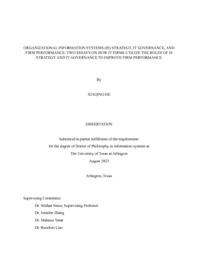
ATTENTION: The works hosted here are being migrated to a new repository that will consolidate resources, improve discoverability, and better show UTA's research impact on the global community. We will update authors as the migration progresses. Please see MavMatrix for more information.
Show simple item record
| dc.contributor.advisor | Nerur, Sridhar | |
| dc.contributor.advisor | Zhang, Jennifer | |
| dc.creator | He, Xiaqing | |
| dc.date.accessioned | 2023-09-27T17:08:50Z | |
| dc.date.available | 2023-09-27T17:08:50Z | |
| dc.date.created | 2023-08 | |
| dc.date.issued | 2023-08-14 | |
| dc.date.submitted | August 2023 | |
| dc.identifier.uri | http://hdl.handle.net/10106/31767 | |
| dc.description.abstract | This dissertation includes two essays. For essay one, we investigate the implications of organizational wireless and mobile strategy on firm performance in the context of publicly traded information technology firms in the United States. A research model is developed to examine the roles of information technology investment and chief information officer compensation in moderating the relationship between wireless and mobile strategy and firm performance. Topic modeling techniques and ordinary least squares regression are employed to analyze the data. The results support the positive effects of wireless and mobile strategy on firm performance. Additionally, chief information officer compensation is found to improve the performance implications of wireless and mobile strategy significantly. Furthermore, information technology investment strengthens the positive impact of wireless and mobile strategy on firm performance.
Essay two examines how a firm's IT governance affects IT investment and, consequently, firm performance, emphasizing the moderating role of risk-taking orientation. The practical implementation and alignment of IT governance practices are crucial for realizing the desired performance outcomes. Furthermore, the mechanism through which IT governance practices influence firm performance remains unclear and limited. Unlike the prevalent use of survey and case study methodologies in the strategic orientation literature, we employ Linguistic Inquiry and Word Count (LIWC) techniques to measure risk-taking orientation in the IT industry context. Drawing on text data from 418 public firms in the IT industry, this study identifies the complete and positive mediating role of IT investment between IT governance and firm performance. Moreover, it finds that risk-taking orientation positively moderates the relationship between IT investment and firm performance. This study contributes to the IT governance literature by shedding light on the underlying mechanisms through which IT governance influences firm performance and the moderating role of risk-taking orientation. | |
| dc.format.mimetype | application/pdf | |
| dc.language.iso | en_US | |
| dc.subject | Wireless and mobile strategy | |
| dc.subject | Firm performance | |
| dc.subject | Information technology investment | |
| dc.subject | Chief information officer compensation | |
| dc.subject | Topic modeling | |
| dc.subject | RBV | |
| dc.subject | IT governance | |
| dc.subject | Risk-taking orientation | |
| dc.subject | LIWC | |
| dc.subject | Firm performance | |
| dc.subject | IT investment. | |
| dc.title | ORGANIZATIONAL INFORMATION SYSTEMS (IS) STRATEGY, IT GOVERNANCE, AND FIRM PERFORMANCE: TWO ESSAYS ON HOW IT FIRMS UTILIZE THE ROLES OF IS STRATEGY AND IT GOVERNANCE TO IMPROVE FIRM PERFORMANCE | |
| dc.type | Thesis | |
| dc.date.updated | 2023-09-27T17:08:51Z | |
| thesis.degree.department | Information Systems and Operations Management | |
| thesis.degree.grantor | The University of Texas at Arlington | |
| thesis.degree.level | Doctoral | |
| thesis.degree.name | Doctor of Philosophy in Information Systems | |
| dc.type.material | text | |
| local.embargo.terms | 2024-02-01 | |
| local.embargo.lift | 2024-02-01 | |
Files in this item
- Name:
- HE-DISSERTATION-2023.pdf
- Size:
- 1.004Mb
- Format:
- PDF
This item appears in the following Collection(s)
Show simple item record


